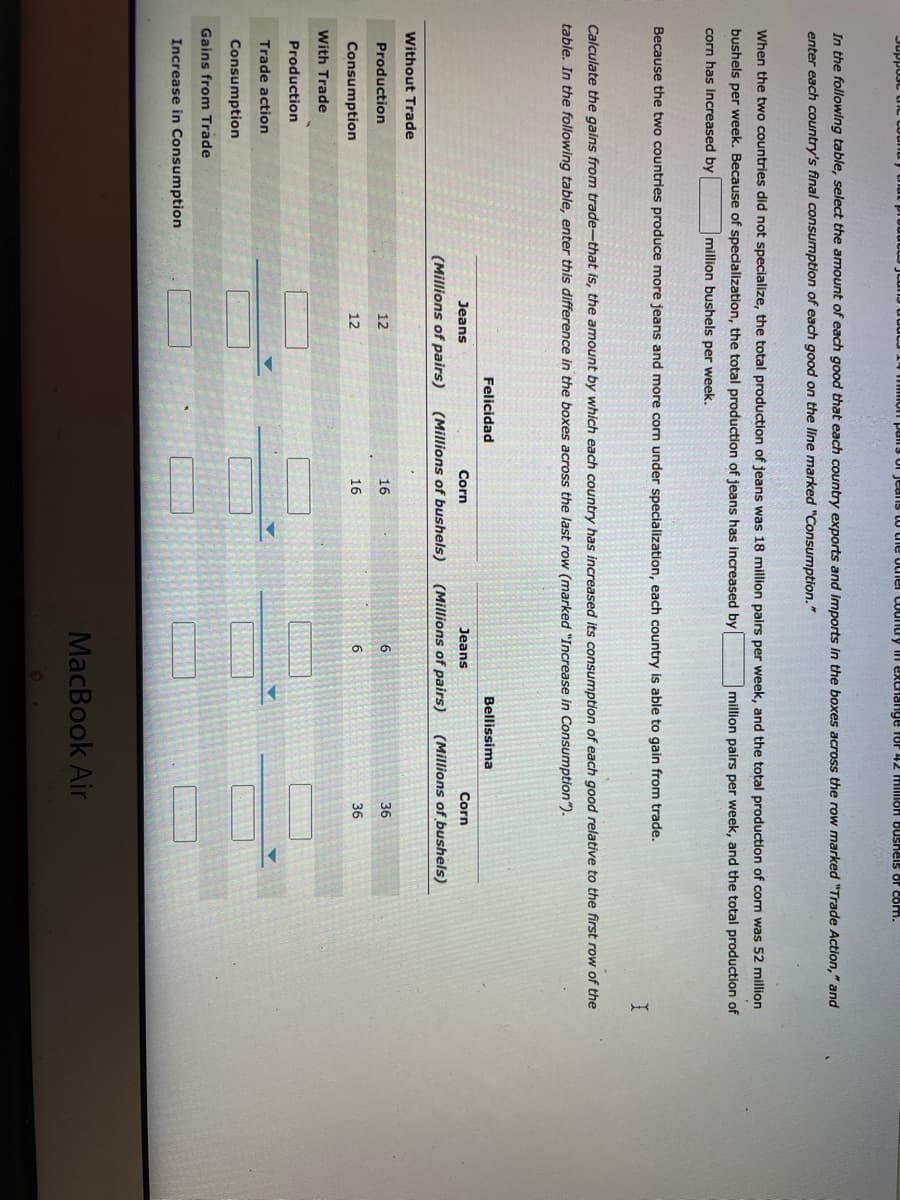3. Gains from trade Consider two neighboring island countries called Felicidad and Bellissima. They each have 4 million labor hours available per week that they can use to produce jeans, corn, or a combination of both. The following table shows the amount of jeans or corn that can be produced using 1 hour of labor. Jeans Corn Country (Pairs per hour of labor) (Bushels per hour of labor) Felicidad 4 16 Bellissima 6 12
3. Gains from trade Consider two neighboring island countries called Felicidad and Bellissima. They each have 4 million labor hours available per week that they can use to produce jeans, corn, or a combination of both. The following table shows the amount of jeans or corn that can be produced using 1 hour of labor. Jeans Corn Country (Pairs per hour of labor) (Bushels per hour of labor) Felicidad 4 16 Bellissima 6 12
Principles of Microeconomics (MindTap Course List)
8th Edition
ISBN:9781305971493
Author:N. Gregory Mankiw
Publisher:N. Gregory Mankiw
Chapter9: Application: International Trade
Section: Chapter Questions
Problem 8PA
Related questions
Question

Transcribed Image Text:Juppost uic counuy thút producca jcuns uduca 14 m on pal3 Ul jeans Lo die ouiiel Country in exchange for 42 hmilllon busnels of comn.
In the following table, select the amount of each good that each country exports and Imports in the boxes across the row marked "Trade Action, " and
enter each country's final consumption of each good on the line marked "Consumption."
When the two countries did not specialize, the total production of jeans was 18 million pairs per week, and the total production of corn was 52 million
bushels per week. Because of specialization, the total production of jeans has increased by
million pairs per week, and the total production of
corn has increased by
million bushels per week.
Because the two countries produce more jeans and more corn under specialization, each country is able to gain from trade.
Calculate the gains from trade-that is, the amount by which each country has increased its consumption of each good relative to the first row of the
table. In the following table, enter this difference in the boxes across the last row (marked "Increase in Consumption").
Felicidad
Bellissima
Jeans
Corn
Jeans
Corn
(Millions of pairs)
(Millions of bushels)
(Millions of pairs)
(Millions of bushels)
Without Trade
Production
12
16
6
36
Consumption
12
16
36
With Trade
Production
Trade action
Consumption
Gains from Trade
Increase in Consumption
MacBook Air

Transcribed Image Text:3. Gains from trade
Consider two neighboring island countries called Felicidad and Bellissima. They each have 4 million labor hours available per week that they can use to
produce jeans, corn, or a combination of both. The following table shows the amount of jeans or corn that can be produced using 1 hour of labor.
Jeans
Corn
Country
(Pairs per hour of labor)
(Bushels per hour of labor)
Felicidad
4
16
Bellissima
6
12
Expert Solution
Step 1
A country has a comparative advantage in producing the good which it produces at a lower opportunity cost than the other country
Trending now
This is a popular solution!
Step by step
Solved in 3 steps with 1 images

Knowledge Booster
Learn more about
Need a deep-dive on the concept behind this application? Look no further. Learn more about this topic, economics and related others by exploring similar questions and additional content below.Recommended textbooks for you

Principles of Microeconomics (MindTap Course List)
Economics
ISBN:
9781305971493
Author:
N. Gregory Mankiw
Publisher:
Cengage Learning

Principles of Economics (MindTap Course List)
Economics
ISBN:
9781305585126
Author:
N. Gregory Mankiw
Publisher:
Cengage Learning

Essentials of Economics (MindTap Course List)
Economics
ISBN:
9781337091992
Author:
N. Gregory Mankiw
Publisher:
Cengage Learning

Principles of Microeconomics (MindTap Course List)
Economics
ISBN:
9781305971493
Author:
N. Gregory Mankiw
Publisher:
Cengage Learning

Principles of Economics (MindTap Course List)
Economics
ISBN:
9781305585126
Author:
N. Gregory Mankiw
Publisher:
Cengage Learning

Essentials of Economics (MindTap Course List)
Economics
ISBN:
9781337091992
Author:
N. Gregory Mankiw
Publisher:
Cengage Learning

Principles of Economics, 7th Edition (MindTap Cou…
Economics
ISBN:
9781285165875
Author:
N. Gregory Mankiw
Publisher:
Cengage Learning

Principles of Economics 2e
Economics
ISBN:
9781947172364
Author:
Steven A. Greenlaw; David Shapiro
Publisher:
OpenStax

Brief Principles of Macroeconomics (MindTap Cours…
Economics
ISBN:
9781337091985
Author:
N. Gregory Mankiw
Publisher:
Cengage Learning